 Jill Biden might not be a full blooded Italian descendant, but there are many Italian-Americans who are only half Italian yet still identify themselves as "Italian" when asked. For instance, I'm a first generation Italian-American with both of my parents being Italian, but my wife has an Italian father and Polish mother. The interesting thing is, she has never really identified as Polish-American since most of her cultural influences growing up were from the Italian side of her family. Even late night TV host Jimmy Kimmel (originally Kummel, from his German paternal grandfather), thinks of himself as Italian-American, since the great family influences were from the Neapolitan side of his mother's family. There has been recent talk of Jill Biden having Italian roots, but I wonder how she identifies herself when asked about her heritage. I'm certain, for politically correct reasons, her answer to journalists would be, "I'm American". Still, in my experience, having even a tiny bit of Italian blood running through someone's veins is enough for anyone to proudly embrace their Italian roots. Who wouldn't want to be Italian? Jill Tracy Jacobs Biden is half Italian. Her grandfather, Domenico Giacoppo emigrated from the small Sicilian village of Gesso, escaping the poverty and chaos created by recent earthquakes in the region of Messina. He later changed his name, in an attempt to Americanize it, to Jacobs. Jill's father, Donald Carl Jacobs (1927–1999), was a U.S. Navy signalman during World War II, who afterwards used the G.I. Bill to attend business school, eventually becoming head of a savings and loan institution in Philadelphia. Her mother, Bonny Jean Godfrey Jacobs (1930–2008), was homemaker of English and Scottish descent. One of Biden's distant Sicilian cousins, Caterina Giacoppo offered an invitation that has gotten a lot of press lately... “Jill, I’m here, my house is open for you, as is our entire Sicilian village of Gesso where your grandfather came from. Please do come visit us next time you travel to Italy.” Gesso is a tiny, close-knit community with only 600 inhabitants in the province of Messina. She went on, "I would be very happy if Jill came here ... I would like to meet her. We are ready to have a nice party all over the commune. If you come, I'll cook you baked pasta, roasted braciolettine arrostite and other local delicacies such as eggplant parmigiana, pasta alla 'ncasciata and cannoli filled with fresh goat ricotta, which is one of my specialties" Flavors of Gesso, Sicily Pasta alla 'Ncasciata is the local, Messinese version of baked pasta with eggplant and caciocavallo cheese. Braciolettine Arrostite is from the Arabo-Sicula cuisine, a mix of Arab and Sicilian flavors. Similar to beef brasciole, it's charcoal grilled with a stuffing of currants, pine nuts and pecorino cheese. Will we be seeing pasta and pizza nights at the White House soon? Only time will tell, but as far as we're concerned, Joe Biden is more than just an Irish-Catholic... he's Italian by sheer association! The evidence is clear since his go-to menu for many past fund-raising dinners includes a caprese salad, angel hair pasta pomodoro, raspberry sorbet, and biscotti. Good luck to them both! --Jerry Finzi E questo è il fiore del partigiano … morto per la libertà! This is the flower of the partisan … who died for freedom April 25, the Festa della Liberazione is an Italian national holiday that commemorates the liberation from fascist domination in Italy. On this day you might hear the partisan song, Bella Ciao on the radio, in parades, or sung by small groups in small town piazzi all over Italy. It is the song of I Partigiani, men and women who fought against the Nazis and Fascists primarily in Northern Italy from 1943 to 1945. This is the period called La Resistenza, the Resistance. The song is set to the melody of a traditional folk song and became the anthem of the Italian resistance movement during World War II, sung by the anti-fascist rebels who fought against the atrocities of the Nazis and Benito Mussolini. The lyrics are symbolic of the sacrifices made for freedom. Each April 25 there are Liberation Day festivities throughout the country, paying tribute to those who lost their lives in in the fight to free their country.  Mussolini, the second from the left Mussolini, the second from the left In 1943, Mussolini was deposed by the King Victor Emmanuel III of Savoy. The new government signed an armistice with the allied forces, while Mussolini was helped by the Nazis, fleeing to Northern Italy where he created a puppet state. After liberating Southern and Central Italy, the Americans passed through the Apennines. Partisans became an effective fighting force against the Nazis and Fascists in the mountain towns. On April 25th, 1945 Northern Italy was at last liberated. Mussolini would be executed by Partisans after a quick, public trial near Milano within 4 days. Shot along with his mistress, Claretta Petacci, and his other henchmen, their bodies were at first laid out in Piazzale Loreto where huge crowds of Italians took turns throwing trash on them, kicking and worse. Afterwards, their bodies were hung upside-down on the rafters of the local gas station. Perhaps a fitting end to one of the monsters of modern history. However, instead of burning the body of Mussolini (as perhaps should have been done) his body was first buried, then stolen, and afterwards found and hidden secretely in a monastary for eleven years. Unfortunately (for the Italy and the World), in May 1957 the newly appointed Prime Minister, Adone Zoli, agreed to Mussolini's interment at his place of birth in Predappio in Romagna. This was for obvious political reasons since Zoli was reliant on the far right to support him in Parliament. Sadly, even today, the remains of Mussolini has become a pro-fascist shrine or sorts. For this reason, it's a very good thing that the Russians "lost" the body of Hitler. Since the Liberation, Italy has been free from dictators, although the current neo-fascist movements are a signal to never forget what history has taught us... --Jerry Finzi Copyright 2019, Jerry Finzi/GrandVoyageItaly.com - All Rights Reserved Not to be published without expressed permission.
 Delmonico's Restaurant in New York City was the first establishment to use the name "restaurant". They were the first restaurant to have printed menus. They were the first restaurant to offer a cookbook. They were the first restaurant to serve women sitting without men at their own table (how shocking!) Delmonico's was also the first dining establishment in America to price individual dishes à la carte, as was the custom in Paris. Before this, American inns served one price and only one dish--no menu. Everyone was charged the same fixed price whether they ate more or less than other patrons. They were also the first to open (for a while) the Delmonico Hotel, without the standard "room and board" pricing, but charged for room and meals separately. They were the first restaurant considered to be "fine dining", attracting celebrities and presidents alike. By 1862, Chef de Cuisine, Charles Ranhofer some of the most famous American dishes such as Eggs Benedict, Baked Alaska, Lobster Newburg and Chicken A la Keene (yes, not "King").Ranhofer published his cookbook, The Epicurean," in 1894.  Giovanni and Pietro Delmonico immigrated from from Ticino, Switzerland, their family roots being in the Trentino region of the Italian Alps. The brothers opened their first restaurant in 1827 in a rented pastry shop at 23 William Street, selling classically prepared pastries, fine coffee, chocolates, bonbons, wines and liquors as well as Havana cigars. In 1831 they were joined by their nephew, Lorenzo Delmonico, who was responsible for the wine list and developing its unique menu. In the coming years, Lorenzo learned every aspect of the restaurant business and was the driving force behind its impeccable standards of both product and service. The Delmonico Farm and Villa In 1834, the brothers earmarked $16,000 (worth $500,000 today) from their profits to purchase a 220 acre farm in the Williamsburg section of Brooklyn. The brothers built an imposing Italian villa at the farm but primarily used the land to cultivate vegetables unknown to Americans for their restaurant, such as endive, sorrel, eggplant, asparagus, Lupini beans, tomato and artichoke. But of course, Delmonico's has become world-renowned for their aged steaks. Their first three restaurants were all destroyed by fire after which they purchased a triangular lot in Lower Manhattan and opening their landmark restaurant at Williams Street in 1893. Marketing geniuses, they claimed the two Corinthian columns at the portico were "salvaged" from Pompeii (many dispute this claim). One early and one later menu from the 19th century  They weren't attempting to serve Italian cuisine by the looks of their original menus, but to offer an upscale "European" menu, which in all parts of Europe during the 17th - 19th centuries were mainly based on Parisian fare. As their popularity with New York's elite grew, the Delmonico family opened other restaurants under the name, operating up to four at a time. In total they had opened 10, illustrating the determination of this family. The popularity of their restaurant (with its high priced menu) drew both local and national politicians, financiers such as Vanderbuilt, luminaries like Mark Twain and Italian inventor Tesla. Domenico's was (and still is) a place to discuss the financing for inventors, presidential campaigns, hob-nob with opera stars and authors... definitely now a place for the hoi polloi or common workers of Manhattan Oscar Tucci bought it in 1926 and turned it into a speakeasy during Prohibition, purchasing the third liquor license in New York after the liquor started flowing again. The Tucci family ran the business as Oscar's Delmonico until the 1980s. Various imitators opened other "Delmonico's" but were unrelated to the original family or its philosophy. Today at the landmark Williams Street restaurant, a large corporation runs a close approximation to the old world dining experience that the Brothers Delmonico first realized. --Jerry Finzi Delmonico's Italian Steakhouse |
On Amazon:
|












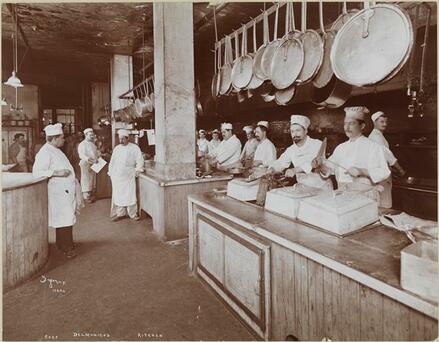
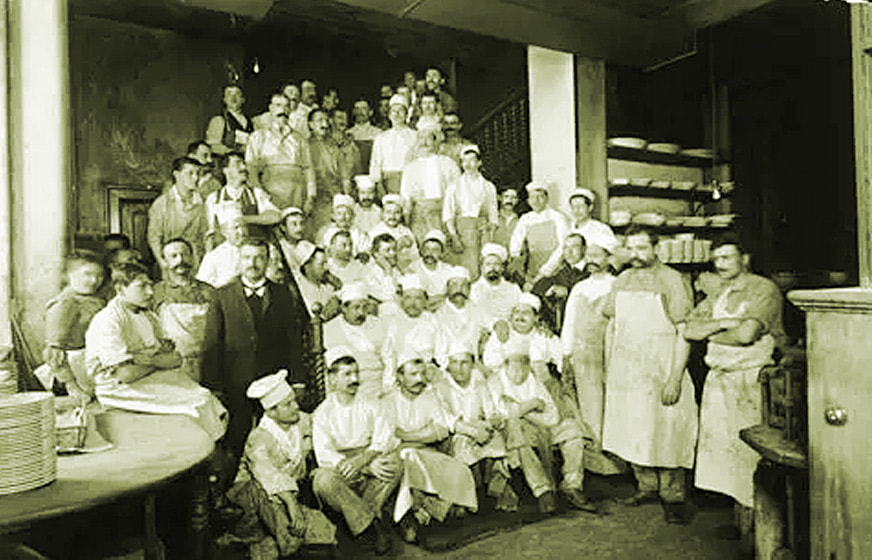





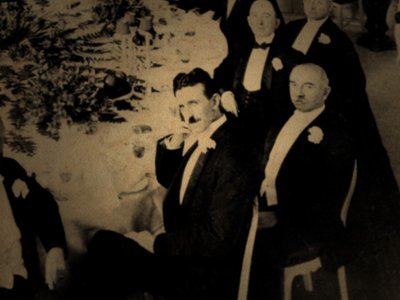
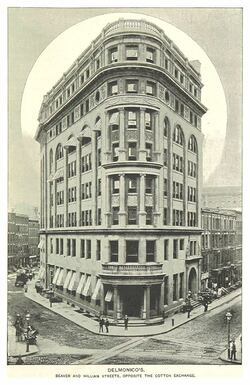


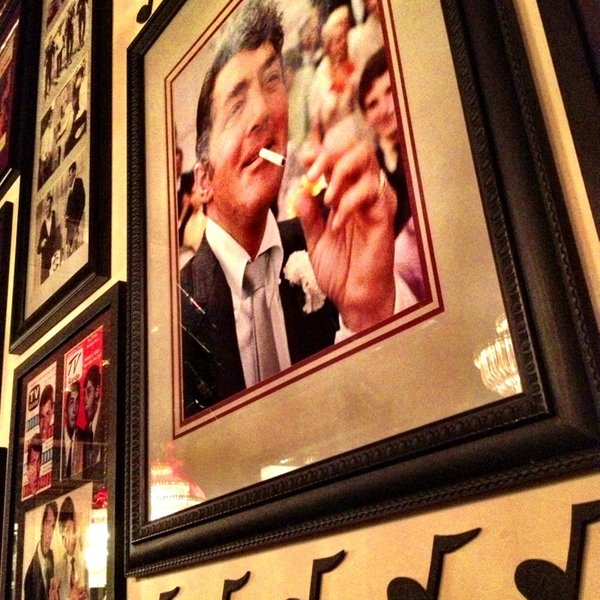








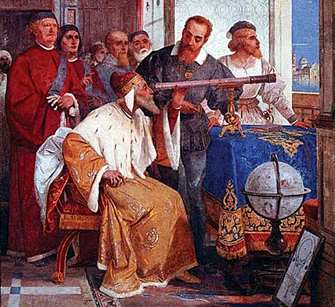








 RSS Feed
RSS Feed
